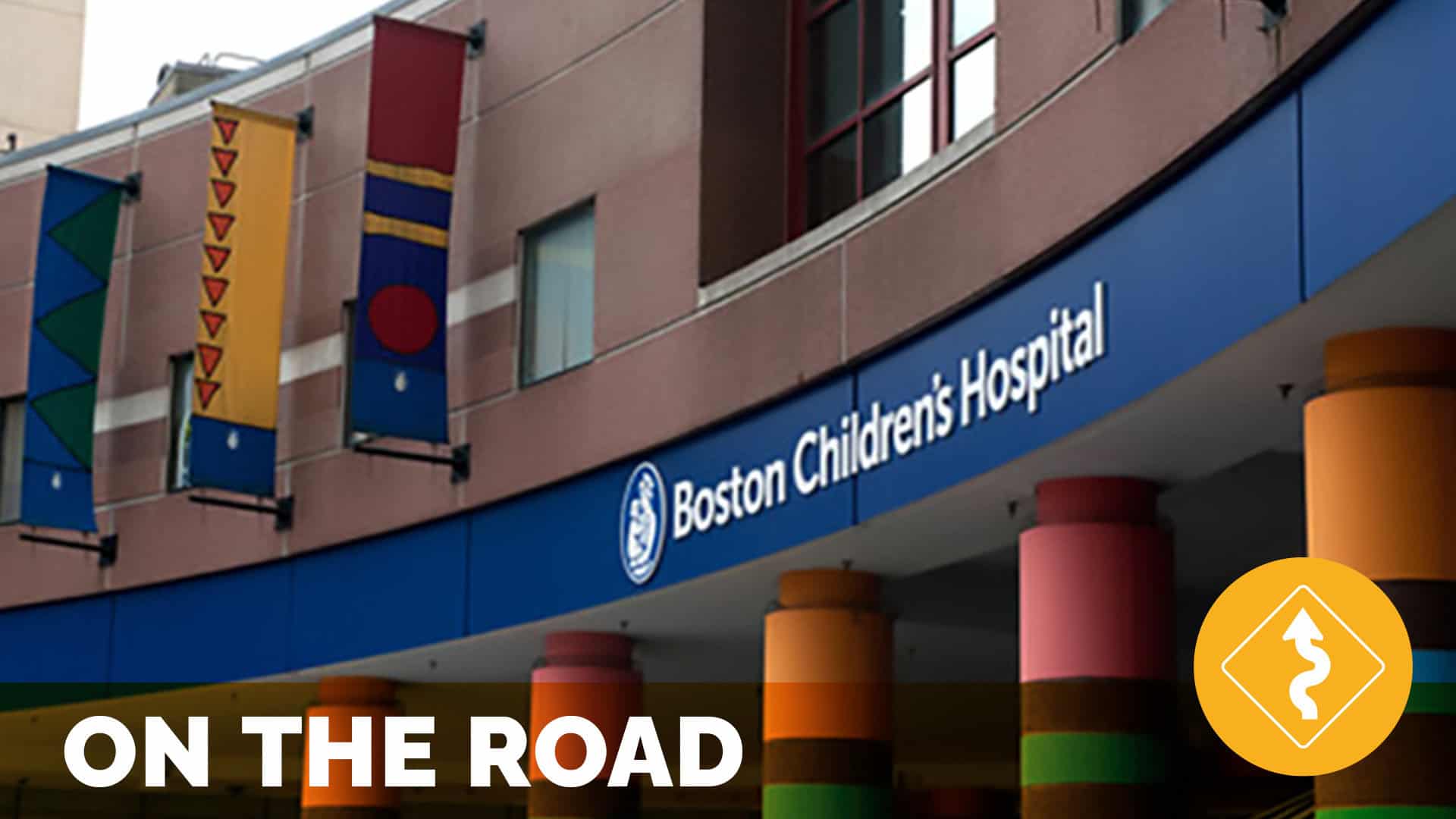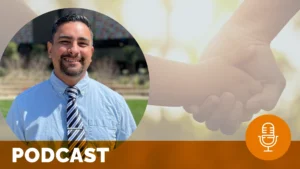Designing Better Experiences with Patient and Family Involvement

On the Road with Boston Children’s Hospital – October 2014
by Deanna Frings and Stacy Palmer
Our latest On the Road took us to Boston Children’s Hospital, a facility with incredible history and an important heritage that still lives today. While Boston Children’s is considered a destination for its clinical excellence and innovations, it is also a community hospital serving the children and families in the Boston area with deep care and compassion. One thing clear throughout our visit was the recognition from all staff that they have as much to learn from the patients and families as they do from the scientists, physicians and care providers.
We started our visit with Elisabeth Harding, director of Family, Volunteer and Interpreter Services, who provided an overview of the patient and family journey currently underway at Boston Children’s. It’s a collaborative journey with the purpose referred to as “achieving a vision and leadership position critical to the future of the hospital.” Boston Children’s construct, focused on the interrelations of communication, environment, culture and access, centers around the idea of “We are All Caregivers.” The hospital’s ultimate patient experience goal is to create a place where patients and families feel confident, respected, valued, inspired and cared for.
Boston Children’s strives to anticipate what people need and have its frontline staff see the journey through the eyes of its patients and families. “Regardless of role from administrator, physician, caregiver to support staff, one common element that connects us all is the patient and we need to all demonstrate certain behaviors of care and compassion and being empathetic,” said Susan Shaw, vice president and associate chief of Nursing and director of Clinical Operations.
Heritage of Discovery and Impact
Through the years, scientists at Boston Children’s have had significant impact in pediatric research, identifying treatments and therapies for many debilitating diseases. Shaw highlighted that the hospital played a pivotal role in controlling tuberculosis. The hospital recognized cow’s milk was a common source of the infection and founded a special lab to produce germ-free milk. They kept a herd of specially bred, tuberculosis-free cows on the hospital lawn to provide milk for patients. A picture of the cows from 1919 hangs on their wall as part of a timeline of the hospital’s history. Also included there is mention of its John F. Enders Pediatric Research Laboratories, named for the Boston Children’s researcher and Nobel Prize recipient who cultured the polio and measles viruses.
Making Way for Improvements
With its deep, impactful history and ongoing recognition (Boston Children’s is the #1 ranked children’s hospital in 8 of the 10 evaluated specialties according to the 2014-15 edition of Best Children’s Hospitals by U.S. News & World Report) the team has a lot to be proud of. However, they acknowledge there is still opportunity for improvement and they were excited to show us some of the projects currently underway.
Seeking More Patient and Family Input
Boston Children’s has a significant focus on involving the patients and families in all efforts. It has very active Family and Teen Advisory Councils and is making efforts to more proactively include both councils in decision making throughout the hospital – from being involved in hiring processes to suggesting appropriate placement and requirements for bathrooms in new additions to selecting art for the walls.
A highlight of our visit was meeting, Linda Delahunty, a patient who co-chairs the hospital’s Teen Advisory Council. Delahunty, now 20, had heart surgery at Boston Children’s at age 16. She was so impacted by the staff and experience that she decided to make healthcare her career. She’s currently studying nursing at Simmons College in Boston, Mass., and hopes to someday return to the hospital as a staff member so she can impact children the way her caregivers impacted her. It’s an incredible reminder of the deep impact we can have on the people we care for. While in school, Linda’s actively contributing to several initiatives on the Teen Advisory Council including a project to help understand and manage the impact on patients and providers when a patient transitions from pediatric to adult care. Delahunty was excited to share other projects being worked on by the Teen Advisory Council including writing letters to state senators on such issues as the dangers of e-cigarettes and opportunities to improve handicap signage.
While Boston Children’s has made great efforts to incorporate patient and family voices, we repeatedly heard an acknowledgement from staff that even more opportunities exist. “Patient and family leadership in care design is central to all we do,” said Laura Wood, senior vice president, Patient Care Services and chief nursing officer. This focus was apparent in all the areas we had the fortune to visit from parking to administration, patient access, volunteer services and even the offsite housing made available to families.
Building Improvements
The building renovations currently underway are one area highly influenced by patient and family feedback. The hospital is undergoing several significant changes to better serve patients and families, including a more welcoming lobby, an easier to find cafeteria with food court-inspired options and clearer navigation. The staff is enthusiastic about the changes, despite the construction challenges they face in the interim. Perhaps the most anticipated of the changes is the new Hale Family Center for Families, scheduled to open in early 2015. Every staff member we encountered lit up when they spoke about the new, facility that will support families with a much larger, easier to access location and increased amenities and offerings.
Parking
We had the pleasure of meeting Jim Smith, department manager, Parking and Commuter Services, who might be more appropriately titled Patient Experience Champion, Role Model, or Mentor Extraordinaire. It was clear as others described Smith preceding our meeting that he has significant impact at this organization well beyond parking (“Oh wait until you meet Jim”…”Oh Jim. He is wonderful…” etc.). He certainly contributes to the organization’s culture, understanding the tremendous impact parking services can have on patients and families and actively looking for ways to improve the parking experience.
With a garage that stays nearly full daily with over 1,600 cars parked in addition to the 400 cars going through valet services, managing the flow is no easy task. Smith acknowledged the importance of setting expectations, explaining that an attendant is positioned at the garage entry to let families know where spaces might be available. His department has also started a “rooftop valet” service. If families do make it all the way to the top without finding a parking spot, they’ll have the option to have their car valeted from there at no charge, saving them from having to drive back to the bottom of the garage to the regular valet area.
Inspired by feedback from patients and family members, Smith has many great visions to further improve the parking experience including better signage, more automated pay stations with live assistance nearby from greeters (who can also help with directions), a discharge lounge adjacent to the parking garage, spaces with awnings for assistance vehicles in the main drive, a bridge to connect the hospital and garage and much more. He sees his role as making things easier for families and visitors and helping the parking staff understand their impact goes well beyond collecting parking fees or valeting cars.
Access/Navigation
Patients and family members are also actively participating in the hospital’s efforts to improve overall access and navigation, a big focus at Boston Children’s. Immediately before meeting with us, Kevin Pawl, director of Patient Access, attended a meeting where a Family Advisory Council member shared her challenges managing care for her two children who combined interact with 20 different departments throughout the hospital. Pawl believes hearing stories like this are critical as his department works to create systems that “talk” and can better coordinate care. His team is working to map the various experiences of local, national and international patients, provide patients with single billing statements that incorporate multiple departments, provide convenient appointment reminders and itineraries via email, text and phone calls.
While his current position is new, Pawl has been with Boston Children’s for more than 26 years in 19 different roles, giving him good insight to impact what he believes his responsibility is: getting people to work together. “Ultimately we are here to help families navigate by building systems that have reliable, repeatable results,” said Pawl.
Health Education
Boston Children’s leaders believe education is a critical and integral part of the patient experience. Realizing that better written materials, care plans and home care policies can help keep people out of the hospital, Kristin Erekson, health education project manager and editor (and our gracious host for most of the day) is focused on building processes for standardized, easy to understand communications. She’s enlisted four families on a volunteer Family Education Steering Committee to help better understand and address patient and family education needs. The families started by creating a survey to better understand patients’ and families’ health education needs that will soon be administered. The results will help to shape future education plans. Erekson sees great opportunity to take communication beyond handwritten materials and brochures. She’s exploring multiple modes of delivery such as hands on instruction and videos and is also exploring ways to meet needs of patients with literacy challenges, blindness and language barriers.
Bringing Smiles and Comfort
Boston Children’s is dedicated to supporting patients and families throughout their experience and offers an array of programs and resources to help make a difficult time a little easier. The campus includes a beautifully maintained outdoor garden and many comforts from home like a playground, a basketball court and multiple resource rooms with computers, video games and books. Cecilia Matos and Kristine Flaherty, program coordinators in the Center for Families, shared details on how they assist families by providing things such as a clothing closet, computer access and even an emerging program to support the growing population of Puerto Rican patients.
Also assisting patients are the 1,200 volunteers who give their time each year co-led by John Porrazzo, program ddministration manager and former volunteer. Whether playing with children during waiting times, providing music or art therapy, greeting families in the lobby or answering phones, volunteers are essential to the Boston Children’s experience.
The volunteer roster even includes dogs through the Pawprints visitation program. After a registering with a therapy dog program and undergoing a thorough screening and orientation process, Pawprints volunteers visit patient rooms and resources rooms throughout the hospital. Patients and family members can pet, play with, talk to or just watch the dog during a visit that typically lasts five to 10 minutes. The dogs provide a diversion from the usual hospital routine and an opportunity for social interaction.
Lynn Belkin, child life specialist and Pawprints coordinator, introduced us to Tucker, an English Cream Golden Retriever, and a veteran of the Pawprints program. We had the chance to play with Tucker and learn about his experience from his owner, Sam. When we asked Sam what he likes most about being part of Pawprints, his answer was simple, “When we walk around the hospital, 99.5 percent of the time, people smile.”
Smiles are also generated through Clown Care, a community outreach program of the Big Apple Circus that brings the joy and excitement of the circus to the bedsides of hospitalized children with juggling, comedy, magic and music. In partnership with the hospital’s medical staff, these performers work one-on-one with acutely and chronically ill children, their parents and hospital staff to help ease the stress of illness by reintroducing laughter and fun as natural parts of everyday life.
We ended our day at the Yawkey Family Inn, one of two hospital-sponsored housing options for patient’s family members. The houses provide affordable accommodations for up to 35 families and are reserved for those living 50 miles or more from the hospital. Each family has their own bedroom and share private bathrooms, kitchen, living room and laundry areas. There are play areas and crafts for siblings, a nice outdoor area and plenty of movies and books available to help pass the time. The housing allows the family to stay close and provides great support and financial peace of mind – both invaluable for families who might be there days or even months.
It is clear Boston Children’s aspires to have its care experiences mirror the innovation it has achieved in clinical care. By supporting a focus on patient and family engagement, the leadership team is helping to apply that strength of excellence to the organization’s overall patient experience efforts.
Special thanks to Elisabeth Harding, Kristin Erekson and the entire team at Boston Children’s for inviting us to spend the day learning about their patient experience journey. We are inspired by their heritage and applaud their focus on including patient and family feedback as they continue to be a leader in pediatric healthcare.
Related content
-
 Environment & Hospitality
Environment & HospitalityYou Can’t Go Wrong If You Do Right by the Patient
Julian Manriquez, Supervisor for Hospitality Services at City of Hope, discusses how his 110-acre campus strives to provide visitors with a five-star transportation and wayfinding experience through a unique Ambassador program. Listen in as he describes the critical roles of innovation and evolution throughout the program’s beginnings, survival during the COVID-19 pandemic, current operations, and
Learn more -
 Infrastructure & Governance | Policy & Measurement
Infrastructure & Governance | Policy & MeasurementA Global Perspective on Experience Excellence: Examples from Around the World
Join Vita Steina to learn more about her Fellow in Human Experience (FHX) project to explore and gather a collection of leading practices driving experience excellence globally. Vita’s project provided a comprehensive look at how organizations around the world are working to advance their experience work in a variety of critical ways. This collection of
Learn more -
 Environment & Hospitality
Environment & HospitalityThe CROWN Project: Promoting Haircare Equity in Hospitals
By: Amanda Pitt, MBA, BSN, RN, MEDSURG-BC, NEA-BC Nursing Operations Specialist and Nurse to Nurse Mentoring Program Administrator Parkland Health | Parkland Center for Nursing Excellence Marygrace Hernandez-Leveille, PhD, APRN, ACNP-BC Nurse Scientist Parkland Health | Parkland Center for Nursing Excellence Introduction Imagine being in the hospital for an extended stay and not having the right
Learn more
